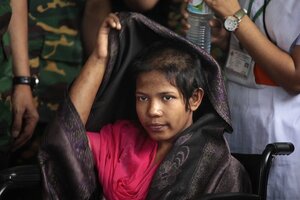Ethical consumers and the Bangladesh building collapse
More consumers act out of empathy after tragedies like the collapse of the Bangladesh garment factory building, forcing global companies to shape up their suppliers in other lands.

Reshma Begum, the seamstress who spent 17 days trapped in the rubble of a collapsed factory building, adjusts her shawl as she meets the media at a hospital in Savar, near Dhaka, Bangladesh May 13. The death toll from the collapse – 1,127 – was the worst disaster in the history of the global garment industry.
AP Photo
Less than three weeks after the April 24 collapse of a Bangladeshi garment factory that killed more than 1,100 workers, four of the world’s largest apparel companies have agreed on a plan to prevent a similar tragedy.
The companies, such as H&M and Primark, had been the target of an online petition by a human rights group that holds such transnational firms accountable for the irresponsible actions of local companies involved in making their goods. In this case, the Bangladeshi building owner who leased space to clothing subcontractors has been cited for neglect of the structure that collapsed.
Backing up the online campaign, however, is a global rise in the number of socially conscious consumers who are selective about the goods they buy, even if they are made thousands of miles away. An implied threat of a consumer boycott and the potential tarring of a corporate brand were real enough to force the apparel companies to insist on a higher level of workplace safety in Bangladesh.
The legally binding plan requires the retailers to pay for factory improvements and to monitor repairs. The government in Bangladesh also agreed to improve factory inspections, although similar promises have been broken in the past. The South Asia country is the world’s second largest apparel exporter after China and doesn’t want to price itself out of the global supply chain of manufacturers.
What accounts for a rise in ethical consumerism, not only in the rewarding of socially responsible clothing makers but in the buying of other goods such as fair-trade coffee, conflict-free diamonds, and forest-sustaining timber products?
It is likely that more people now have easy access to activist tools like the Internet and the freedom of choice in the marketplace to enable them to feel as if they can make a difference in far-flung lands. Supply chains are now easier to trace.
Ethical consumers act differently from consumers merely concerned about products that might harm themselves. The ethical consumer has a selfless empathy and an elevated moral understanding of what connects people across nationality, race, or creed. And often, purchasing an alternative product comes with a sacrifice in cost, quality, or convenience. That takes a certain inner stamina.
Not all consumer boycotts work well. Some can have negative results, such as in Africa where a boycott of conflict minerals has led to more criminalization of the minerals trade. Consumers need information to know if their individual action will have the intended outcome.
Yet the world should rejoice that the “invisible hand” of ethical purchases has become strong enough to force a quick remedy after the Bangladesh disaster. Empathy knows fewer boundaries. And more companies feel a moral sting more quickly from their egregious behavior.

